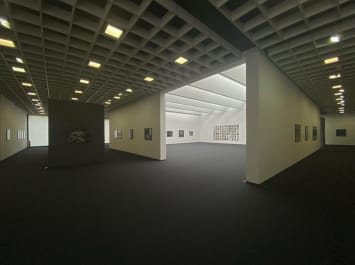The exhibition, conceived jointly by Jean-François Chevrier and Heinz Liesbrock with the artist, provides an overview of Patrick Faigenbaum's work, from his earliest images in the 1970s to the most recent developments. It includes 52 'old' works (representing 79 images) and 20 unpublished works divided into several sets (totalling 99 images, the oldest taken in 2014).
This is not an exhaustive retrospective but a journey built around some of the lines that structure a corpus of more than forty years: the relationship between object, body and sculpture via the portrait; the question of the inscription of family ties and genealogy in everyday places and in history, with a predominance of the maternal figure; the urban investigation at the crossroads between individual destinies and historical gravity; the search for a tactile quality of the image.
The exhibition begins with a selection from the series with which Patrick Faigenbaum made his name: Italian Families (Florence, Rome, Naples, 1984-1991), presented alongside a group (1987-2020) consisting of three portraits of the artist's mother and images of sculptures: busts of Roman emperors, Medardo Rosso's Bambina che ride, archaeological objects, etc.
The next sequence is devoted to images of Prague (1993-1994), an essential milestone in the artist's work, followed by the emergence of colour with the ensembles devoted to the cities of Bremen (1996-1998) and Kolkata/Calcutta (2010-2014). An exhibition in Germany must consider the turning point represented by the urban study in Bremen and make clear its motives and implications. This selection can be adapted to each exhibition venue, shifting the focus to other cities in which Patrick Faigenbaum has worked, such as Paris, Barcelona or Tulle.
A small group of still lifes testifies to Faigenbaum's lifelong interest in this pictorial genre; compositions and arrangements of objects are linked to places (in this case Santulussurgiu, in Sardinia, and Calcutta), in a relationship with the exterior.
This tour takes place around the vast square space that marks the center of the Josef Albers Museum. In this room, with its high picture rails and overhead lighting, a new dialogue is presented between two great maternal figures and their corresponding places: the artist's mother and her flat in Rue de Clichy, Paris; the mother of Angela Ledda, the artist's companion, and her village in Sardinia.
The last sequence of the exhibition, which completes the tour by taking the visitor back to the entrance, establishes a relationship between the oldest images (1974-1980), in black and white, and a group of very recent colour images taken in Paris.
Small format images, contact sheets, books and documents are presented in window displays.
The exhibition is accompanied by a catalogue book published by Schirmer Mosel, with texts by Heinz Liesbrock, director of the Josef Albers Museum, and Jean-François Chevrier. This is the first retrospective book since 2014, after the catalogue for the Gulbenkian Foundation (Lisbon, 2007), the one for the Vancouver Art Gallery / Villa Medicis (2013), and L'Éclairement (Éditions Xavier Barral, 2014), devoted to black and white images.
This is not an exhaustive retrospective but a journey built around some of the lines that structure a corpus of more than forty years: the relationship between object, body and sculpture via the portrait; the question of the inscription of family ties and genealogy in everyday places and in history, with a predominance of the maternal figure; the urban investigation at the crossroads between individual destinies and historical gravity; the search for a tactile quality of the image.
The exhibition begins with a selection from the series with which Patrick Faigenbaum made his name: Italian Families (Florence, Rome, Naples, 1984-1991), presented alongside a group (1987-2020) consisting of three portraits of the artist's mother and images of sculptures: busts of Roman emperors, Medardo Rosso's Bambina che ride, archaeological objects, etc.
The next sequence is devoted to images of Prague (1993-1994), an essential milestone in the artist's work, followed by the emergence of colour with the ensembles devoted to the cities of Bremen (1996-1998) and Kolkata/Calcutta (2010-2014). An exhibition in Germany must consider the turning point represented by the urban study in Bremen and make clear its motives and implications. This selection can be adapted to each exhibition venue, shifting the focus to other cities in which Patrick Faigenbaum has worked, such as Paris, Barcelona or Tulle.
A small group of still lifes testifies to Faigenbaum's lifelong interest in this pictorial genre; compositions and arrangements of objects are linked to places (in this case Santulussurgiu, in Sardinia, and Calcutta), in a relationship with the exterior.
This tour takes place around the vast square space that marks the center of the Josef Albers Museum. In this room, with its high picture rails and overhead lighting, a new dialogue is presented between two great maternal figures and their corresponding places: the artist's mother and her flat in Rue de Clichy, Paris; the mother of Angela Ledda, the artist's companion, and her village in Sardinia.
The last sequence of the exhibition, which completes the tour by taking the visitor back to the entrance, establishes a relationship between the oldest images (1974-1980), in black and white, and a group of very recent colour images taken in Paris.
Small format images, contact sheets, books and documents are presented in window displays.
The exhibition is accompanied by a catalogue book published by Schirmer Mosel, with texts by Heinz Liesbrock, director of the Josef Albers Museum, and Jean-François Chevrier. This is the first retrospective book since 2014, after the catalogue for the Gulbenkian Foundation (Lisbon, 2007), the one for the Vancouver Art Gallery / Villa Medicis (2013), and L'Éclairement (Éditions Xavier Barral, 2014), devoted to black and white images.
